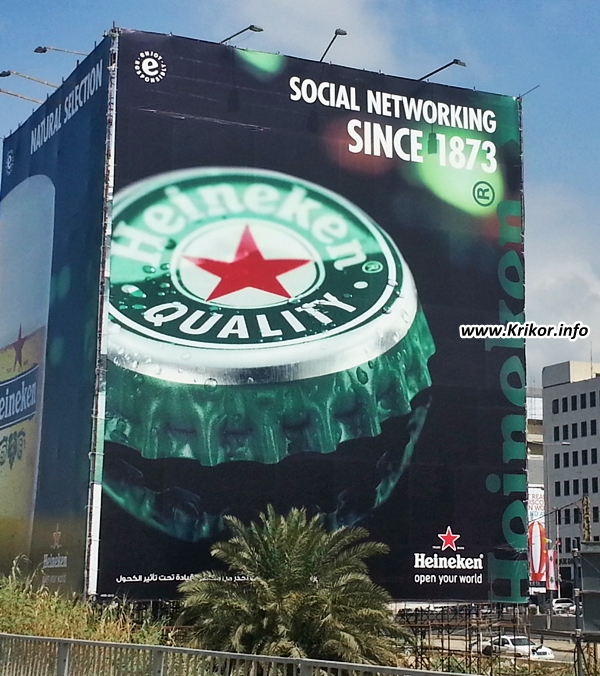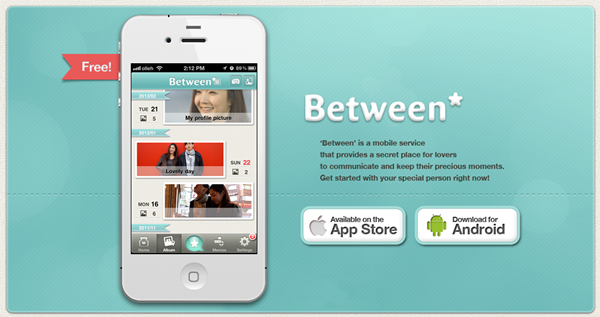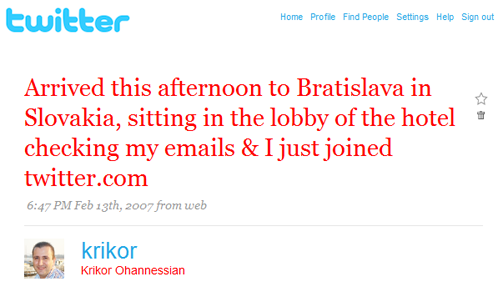Since 1873
Heineken latest “huge” billboard campaign in Lebanon, it looks they are in the social networking business since 1873.

Heineken latest “huge” billboard campaign in Lebanon, it looks they are in the social networking business since 1873.

If both a couple owns an iPhone and/or an Android based phone and are in love, then Between is the app they need to have on their mobile smartphone.
Between is a mobile service that provides a secret place for lovers to communicate and keep their precious moments.
The Korean entrepreneurs behind Between had a charming idea: Let couples create one-on-one social networks for purely private sharing.
With the app, two people can connect with each another to share private photos and secret messages. The private “chat” function includes support for emoticons, so you can dress up your sweet nothings with as many smiley faces, winks, and hearts as your sweetie can stand. In the future, the network could support coupons or other offers, enabling marketers to reach the desireable demographic of young, happy couples in search of romantic experiences and adventures.

May 2011 | THE F-FACTOR, which is all about how friends, fans & followers greatly influence consumers’ purchasing decisions in ever-more sophisticated ways.


So much has been said about social media and the rise of social commerce as the new marketing frontier that we’re not going to (re)make the social case here. Instead, we’ll focus on how the influence of friends, fans, and followers on consumers’ purchasing decisions continues to become more sophisticated and thus more powerful. Let’s call it the F-FACTOR:
THE F-FACTOR | Consumers are increasingly tapping into their networks of friends, fans, and followers to discover, discuss and purchase goods and services, in ever-more sophisticated ways. As a result, it's never been more important for brands to make sure they too have the F-FACTOR.
Why is the F-FACTOR important to consumers? It offers the promise of a consumption arena* that is more efficient, more relevant, and more interesting than before, where consumers either had to spend endless time and effort on trying to discover the best of the best, or had to rely on sources that were distant, unknown or untrusted (read: brand-driven), and therefore potentially unreliable or irrelevant.
Of course, consumption has always been social: people have forever been influenced by what those around them think and buy. KellerFay, a US word of mouth marketing research consultancy, estimates that there are nearly one trillion conversations about brands every year in the US alone.
But, just as with so many consumer trends, while the core consumer behavior isn’t new, technological developments are unlocking new manifestations of that behavior, which here amplify its importance and impact. Indeed, the F-FACTOR is being fueled by new tools and platforms available to both consumers and brands, and by the sheer numbers of people now using and contributing to these tools.
Note: This Trend Briefing focuses on the new ways consumers’ purchasing decisions are being influenced by their friends, followers and other people they “know”. For more on consumers who actually contribute, see our 11 Crucial Consumer Trends for 2011, where we looked briefly at the rise of SOCIAL-LITES, and the phenomenon of why consumers are increasingly becoming curators; actively broadcasting, remixing, compiling, commenting, sharing and recommending their purchases and experiences to both their friends and wider audiences. Hint: it’s it all to do with the changing STATUSPHERE, as always ;-)

(Picture credit: 55His.com)
Just a few recent stats demonstrating the reach and power of the F-FACTOR:
And a couple of brand-related, F-FACTOR stats:

So, here are just five of the ways that the F-FACTOR influences consumption behavior:
* This Trend Briefing is about the impact of consumers’ social connections on how they find, decide and purchase: i.e. what happens when consumption is increasingly social, rather than the personalized retailing opportunities on social networks (which is currently still the main focus of F-COMMERCE). For more on this see the excellent Social Commerce Today.
One final caveat: there are a whole host of ways in which consumers are influenced by other consumers, from collaborative filtering and ‘social’ or collective intelligence models. But to try and save this from turning into a book, this briefing will focus on consumers’ existing or explicit social networks.


Consumers’ ongoing obsession with owning or experiencing the best of the best and their desire for serendipity, excitement, interaction and community, explains the pull of F-DISCOVERY. People are curious and interested in what their friends and contacts think, do, eat, read, listen to, drive in, travel to and buy, because often this will be similar to how they want to think, act and buy.
No surprise then that consumers are embracing communities, tools and apps that allow them to dive into and discover selections from friends, fans, followers and so on. Just a few examples:




While consumers sometimes enjoy finding the best of the best through discovery, they are increasingly able to access personalized recommendations and reviews on something they know they want to purchase. In fact, expect more and more sites to automatically serve up friends’ recommendations, ratings and reviews* next to goods and services that people are researching.




* Privacy concerns are of course the elephant in the room here. Ensuring that consumers maintain control and choice over when and where their information ends up is one of the big challenges for brands. But that’s for another briefing. In the meantime, check out the Wall Street Journal’s excellent (if scary) What They Know feature.


Over the last decade, online reviews have greatly empowered consumers (see TRANSPARENCY TRIUMPH). But anonymous reviews aren’t always what consumers need or want; they can lack relevance and context, and consumers with many options sometimes just want an unambiguous, or finite opinion.
Which is where F-FEEDBACK comes in: consumers actively disclosing their purchasing intentions and reaching out to their friends and contacts for personalized feedback.
Some indicators:
One more key driver here: with more and more consumers increasingly viewing their online reputation as something to enhance as well as just protect, the quality of answers on Q&A services is rapidly improving. Some examples:

There are also a whole host of sites for consumers who want tips and recommendations about which products and services to purchase, rather than more general Q&A:

Due to the continued spread of smartphones, F-FEEDBACK can happen in real-time too:


Check out these examples of how friends can now come into the fitting room ;-)

More and more online consumers are also sharing and discussing potential purchases with their friends in real-time:


While group-buying platforms such as Groupon are revolutionizing local retail (see our PRICING PANDEMONIUM trend), consumers usually don’t actually know the other members of the group that they’re buying with. So, while consumers get to leverage the power of the web to benefit from better deals, the actual shopping experience frequently lacks the F-FACTOR. Consumers, of course, have strong incentives to share certain purchases, especially for F-FACTOR-friendly experiences such as buying event tickets: what’s not to like about automatically inviting friends to a concert or movie right after purchasing a ticket?

So, expect to see more tools that help consumers easily share and co-ordinate relevant purchases with their close friends and family, but for now we’ll just highlight a few:


The F-FACTOR also makes possible personalized products and services based on the activities and output of one’s social network:

Oh, and check out these very ‘sign of the times’ F-ME examples of consumers literally turning their friends and followers into actual physical products and services:

With the F-FACTOR a growing force in the consumption arena, ultimately the only way for brands to succeed is to be liked (literally ;-) if not loved, and this liking and loving comes from superior performance. In that sense, the Perform or Perish theme is stronger than ever, and underscores that while the F-FACTOR is currently playing out in the online arena first and foremost, this is in the end about business at large.
The F-FACTOR is about being so exceptional that consumers will find and ultimately choose you, without you as a brand having to do anything extra. It’s not about bribing or even compelling people to “Like” your Facebook page. This is something of course, which brands that truly have the F-FACTOR don’t have to worry about.
So, for all ‘F-entrepreneurs’, this space is still wide open: simply come up with new tools and platforms that help consumers help each other to discover, discuss and buy the best of the best. For B2C brands, it’s time to deliver innovations, products, campaigns and experiences that truly have the F-FACTOR.
Source: www.trendwatching.com. One of the world’s leading trend firms, trendwatching.com sends out its free, monthly Trend Briefings to more than 160,000 subscribers worldwide.
 For those who are not familiar, the terms bull market and bear market describe upward and downward financial market trends, respectively, and can be used to describe either the financial market as a whole or specific sectors and securities.
For those who are not familiar, the terms bull market and bear market describe upward and downward financial market trends, respectively, and can be used to describe either the financial market as a whole or specific sectors and securities.
Lately people are trying to make these two financial market enemies come more close and socialize through networks. A social network is a social structure made up of individuals (or organizations) called “nodes”, which are tied (connected) by one or more specific types of interdependency, such as friendship, kinship, common interest, financial exchange, dislike, sexual relationships, or relationships of beliefs, knowledge or prestige.
Today I read a tweet on my timeline that eTrade is launching its social platform. Well eTrade are losers for 3 reasons, first because it is not a coincidence that 2 days ago i wrote this blog post about their bad customer service and how they pushed me and another 1,200 clients from their Dubai office, to shut down or transfer our accounts, second because it took them so long to realize that stock traders can also network to share trading ideas, charts settings and technical analysis, third because already some other players took the stocks social networking to another level.
Below is a list of few stocks social networking sites that can bring more trading value mainly to beginner and intermediate traders. I am sure there are many others out there, so feel free to comment about them.
![]()
StockTwits® is an open, community-powered idea and information service for investments. Users can eavesdrop on traders and investors, or contribute to the conversation and build their reputation as savvy market wizards. The service takes financial related data and structures it by stock, user, reputation, etc.
![]()
Keep track of like-minded traders, view their trades and emulate their strategies with myTRADE, see real trades of other myTRADE users as they share them.
myTRADE, Inc. and TD Ameritrade are separate but affiliated companies.
![]()
SocialPicks is a community for stock market investors to share investment ideas, exchange market research, and track peers’ investment performance. SocialPicks also tracks picks by gurus (e.g. Warren Buffett & Jim Cramer), professional analysts, and various financial bloggers so you can see how well you perform against them.

BullsOnWallStreet is an interactive stock website designed by active traders. Whether you have experience trading stocks or none at all we are here for you. If you’ve never bought or sold a stock before and you want to learn some of the tricks of the trade from some experienced people try us out! We offer a live trading floor where you can watch and follow our trades. We also offer mentoring, active daily stock picks, and our pro members receive significant benefits that you won’t find anywhere else.
![]()
Founded in 1993 in Alexandria, VA., by brothers David and Tom Gardner, The Motley Fool is a multimedia financial-services company dedicated to building the world’s greatest investment community. Reaching millions of people each month through its website, books, newspaper column, television appearances, and subscription newsletter services, The Motley Fool champions shareholder values and advocates tirelessly for the individual investor.

TheLion.com is a growing financial web 3.0 community site for active traders and investors. We offer a highly-integrated community for all stock due diligence process. Users are empowered to share and educate profitable investment ideas across the site medium 24/7. TheLion.com is all about web 3.0 – the process of achieving one’s own financial goals and satisfaction in life.

Stockpickr, a wholly owned subsidiary of TheStreet.com, was named one of Time.com’s 50 best Web sites in 2007 and was one of the first sites to combine social networking with stock investment ideas. Stockpickr’s Stock Idea Network provides members with windows into the stock picks of other community members as well as professional investors, sparking discussion via idea-sharing forums and products.

Most investing websites force people to think in the language of ticker symbols. Wikinvest lets you start with concepts, which can be things like themes, ideas, trends, products, and industries. Wikinvest has created an intuitive way to browse investing content by concept articles, which then explain which companies are impacted and why.

Investimonials.com is a place to discover the best financial products…and to weed out the worst. With thousands of financial products and talking heads out there, how are you to know what products are worth using? Discover products you never knew about and share your input on the products you’ve used in the past.

Profit.ly was created by Timothy Sykes & Michael Mosseri to discover the most profitable investors and traders while weeding out the worst. Simple goal but huge task as the online financial world is as transparent as Bernie Madoff’s hedge fund days.
![]()
One last service I would like to mention and is not a stock social networking but related to stocks and traders is Tringz, a free, real-time stock market browser for all traders out there using Twitter from their mobile smartphones (all platforms and operating systems).
Users can read comments and tweets from traders and investors and can also benefit from Tringz to confess about their daily trading feelings or opinions about stocks on their portfolios.
Tringz can also be used as a regular twitter mobile client.
And then came Facebook… and I am trying hard to remember when I first joined this social network after many insisting requests from my work colleagues and it happened, I had my profile with very limited gadgets and accessories when FB took the internet by storm and became the story to tell in every gathering of friends and family, even between strangers having coffee in the same shop.
I got so excited about it that I even registered 2 domain names, facebookist.com and facebookism.com and later on to be contacted by the law firm handling worldwide intellectual properties of FB asking me to handle in the 2 domains and after long email communications where we got to nowhere, I still have the 2 domains and shut down my FB profile for almost more than a year, for no specific reason, I just felt I can live without it and moved into more professional social networks.

Then one day re-activated my account again without any justification, but here came the status quo where I really did not care about it and started logging-in once a week and sometimes every 2 weeks, it did not mean much, while lots of freelancers and companies were developing new add-ons and applications to enhance your FB experience, from games, to places I have been, to pets to do you like me or not, and on and on and on… but all this did not really attract me. Also not long time ago FB re-engineered their total look which was also another dull thing to me.
To summarize the above, I got bored from Facebook.
Then earlier this year I found myself attracted back again to Twitter, for those who are not aware of what this is all about, Twitter is a service for friends, family, and co–workers to communicate and stay connected through the exchange of quick, frequent messages. People write short updates, often called “tweets” of 140 characters or fewer. These messages are posted to your profile or your blog, sent to your followers, and are searchable on Twitter search.
I first joined Twitter for more than 2 years now, my below twit is my first one, since then, the service did not change much, still have the same interface, no extra stuff added to the menu, even lots of people and companies are building amazing apps and sites around their API, but still the Twitter guys are keeping it simple, so far!

Nowadays I really enjoy twitting, from the office, while on the go, from bed, while driving, from anywhere, but for how long? I even got excited the same way I got for FB and registered 2 domains twtfight.com and twtwar.com with the idea of making a stupid site where people can twit and fight over a given subject, mainly it was about men vs women.
So will twitter keep me excited the same way it is doing now or I will get bored soon?
We will see and I will let you know if it ever happens.